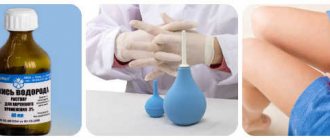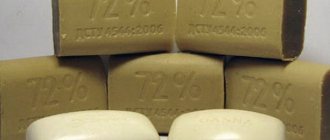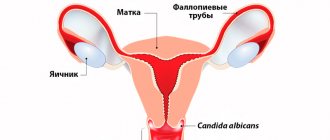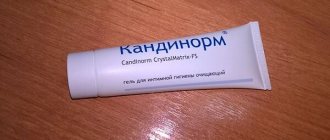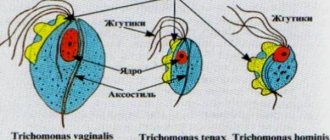H2O2 has a number of useful medicinal qualities that are successfully used for vaginal candidiasis. But you should understand that if used incorrectly, this drug can cause significant harm. It is extremely important to know how it works and how it is used. A feature of the pathology is frequent relapses, so only complex therapy is suitable to get rid of the disease. The healing properties of 3% peroxide have long been used in gynecology, because peroxide is an environmentally friendly pharmaceutical product. At home, treating thrush is possible only if the recommended precautions are strictly followed.
How does peroxide act on candidiasis?
Hydrogen peroxide helps in the treatment of vaginal candidiasis in women, mainly by douching. The effectiveness of peroxide therapy is due to the beneficial antiseptic properties of the drug, which is important for neutralizing thrush. This antioxidant destroys toxins and has a detrimental effect on infections and viruses. When 3 percent hydrogen peroxide enters the vagina, a chemical reaction occurs that causes the peroxide to break down into water and molecular oxygen.
The oxidative effect on pathogenic microelements is obtained due to the interaction of H2O2 with the mucous membrane and skin. Atomic oxygen ensures the mucus foams, thereby destroying the harmful fungus. Thrush pathogens come out of the vagina along with the discharge. In addition, treating thrush with a peroxide solution eliminates the fungal infection; this drug has a beneficial effect on the entire body:
- normalizes acid-base balance;
- saturates the blood with oxygen, which improves its composition at the molecular level;
- regulates the production of thyroid hormones;
- accelerates the restoration (regeneration) of damaged tissues;
- restores the functionality of the gastrointestinal tract;
- does not cause pain when applied.
Important!
During the sanitation of the genital organs for candidiasis, pathogenic microorganisms are destroyed. By neutralizing the activity of the Candida fungus, the woman’s immune system increases, which has a positive effect on the vaginal microflora, bringing it to a healthy normal. To benefit from home therapy for candidiasis with hydrogen peroxide, be careful, otherwise you may get a burn to the mucous layer of the vaginal walls.
Causes of thrush
Vaginal candidiasis (thrush) occurs very often in women.
With this disease, discharge occurs that has the characteristics of cheesy, white, accompanied by burning and itching in the external genitalia. It should be noted that in small quantities this fungus is a normal part of the microflora. But when factors are favorable for it, it begins to develop rapidly and cause unpleasant symptoms.
Factors that provoke the proliferation of this fungus include:
- decreased immunity,
- hormonal imbalance,
- unhealthy diet
- frequent stress,
- long period of taking contraceptives and antibiotics,
- wearing synthetic underwear,
- chronic diseases of the genital organs,
- pregnancy period,
- diabetes,
- HIV,
- allergic diseases.
Remember, if thrush is not treated promptly, it can further affect the bladder and intestines.
Speaking about the symptoms of the disease, the following should be noted:
- itching and burning in the external genital area,
- the appearance of cheesy discharge,
- inflamed genital mucosa,
- painful sensations when urinating,
- painful sensations during sexual intercourse.
Of course, in order to establish an accurate diagnosis, it is necessary to consult a doctor who, upon confirmation of the diagnosis, may prescribe douching with medications, in particular perhydrol solution.
Thrush often appears in women before menstruation, and the more allergic the woman, the more severe the manifestations.
There are 2 types of causes leading to thrush. These are exogenous and endogenous.
Endogenous causes include:
- weakened immune response: untreated STIs, pregnancy, gastrointestinal diseases;
- chronic diseases of organs and systems of the body;
- endocrinological disorders: diabetes mellitus, obesity;
- long-term use of antibiotics;
- wearing synthetic pads daily;
- long-term use of hormonal contraceptives;
- violation of diet: consumption of foods high in carbohydrates, abuse of fried, canned and smoked foods;
- psychosomatic phenomena such as severe stress.
Exogenous causes:
- sexual contact with an infected Candida fungus, under a number of circumstances (low resistance of your body, disrupted hormonal levels);
- in case of close contact with a patient with candidiasis, use general hygiene products;
- in the first year of life.
Often thrush does not come alone, and along with it there may be infectious diseases such as trichomonas, gonorrhea, and chlamydia. Therefore, complaints may not be standard, however, there are symptoms characteristic only of thrush.
How to douche with peroxide for thrush in women?
Treatment of the vaginal mucosa with peroxide for candidiasis remains one of the most popular methods of alternative medicine, despite the fact that today modern pharmacology offers a lot of remedies.
Douching for thrush is carried out strictly according to a certain algorithm. First of all, you need to make the right solution so that the concentration is not compromised. The recipe and procedure diagram is as follows:
- Buy a gynecological syringe at the pharmacy and boil it before use. In the future, this must be done before each use.
- Boil 250 ml of water. This is a one-time volume.
- Then cool to room temperature.
- Carry out hygiene procedures with boiled water (washing - without soap/gels).
- Next add 1 tbsp. l. peroxide solution concentration 3%.
- Take a comfortable position (lying or standing) and gradually introduce the prepared mixture into the vagina in small portions.
For a greater anti-inflammatory effect, you can add a tablespoon of chamomile or chamomile decoction to the solution, or 2-3 drops of tea tree essential oil. The addition of herbal decoctions has a calming effect on the mucous membrane of the female pelvic organs. After douching, you should not immediately wash yourself, so as not to wash out the medicinal mixture (this hygienic procedure can be done in 15-25 minutes), and it is also not recommended to use tampons.
The frequency of treatment procedures is determined by the degree of the disease. On average, the duration of the course is 7-10 days, taking into account daily administration once a day. After complete neutralization of the signs of thrush, douching should be done another 3-4 times a week - every other day. This is done to consolidate the result. When treating vaginal candidiasis with peroxide, the development of the fungus slows down, and already on the 1-2nd day after the start of the healing course, unpleasant sensations (discharge, itching, burning) are noticeably reduced.
Recipes for douching solutions and tampons
For treatment, you must first prepare a 1-2% solution of mumiyo (buy at a pharmacy). Then add to 200 ml of the resulting solution:
- 1 day - 10 drops of 3% hydrogen peroxide;
- Day 2 - 15 drops;
- Day 3 - 20 drops.
- Days 4 and 5 - 20 drops.
This solution can be used as a microenema in the rectum after cleansing the intestines for inflammatory diseases of the appendages; for douching and tampons for problems associated with pathological processes in the vagina and cervix.
The course of treatment is 5 days, 2 days break. You can do up to 5 such courses. During the break at night, put tampons with aloe juice or sea buckthorn oil. Peroxide is very drying, so it is better to use tampons that nourish the epithelium at night on break days.
Another recipe that doctors often recommend: 1 teaspoon of 3% peroxide per glass of water. This mixture is more aggressive; when applied, it causes a tingling sensation that quickly passes. Do not use for more than 3 days, otherwise it dries out the mucous membrane very much.
Important tips for douching
Douching with 3% hydrogen peroxide must be carried out in compliance with the rules and recommendations, this is the only way to solve the problem - candidiasis.
- Use only a sterile syringe.
- The solution should be prepared and H2O2 should be added only to water that has been boiled and cooled to room temperature. It is strictly forbidden to dilute peroxide in boiling water!
- You cannot prepare a large volume of medicine for thrush in advance - only a single dose.
- Add peroxide to the water immediately before douching.
- It is strictly forbidden to increase the dosage of hydrogen peroxide.
- Peroxide against thrush is used after hygienic procedures.
- It is not recommended to end therapeutic douching immediately after the first relief. It is extremely important to carry out a full course of treatment until the symptoms of candidiasis completely disappear.
Features of application
Accurate adherence to all stages of treatment will help you get rid of thrush with the help of Hydrogen Peroxide. First of all, you need to adjust your diet and reduce your carbohydrate intake. Use loose, breathable cotton underwear for constant wear.
You cannot increase the concentration of Hydrogen Peroxide for douching and the duration of the procedure , since this can cause not only irritation of the mucous membrane, but also burn it.
It should be remembered that Hydrogen Peroxide becomes unstable in an alkaline environment, at elevated temperatures and in bright light. Therefore, the drug can only be stored in a place protected from the sun at room temperature.
For thrush, you need to prepare a fresh solution for douching every time, since it quickly loses its properties.
During procedures, avoid contact of the product with the eyes and esophagus. If it is still not possible to avoid the penetration of hydrogen peroxide into the esophagus, it is necessary to perform gastric lavage using thiosulfate (0.5%) or sodium bicarbonate, as well as intravenous administration of sodium thiosulfate.
If hydrogen peroxide gets on the mucous membrane of the eye, it is necessary to rinse the eye under running water.
If the doctor has prescribed the use of hydrogen peroxide in combination with vaginal tablets for thrush, then it would be best to carry out the procedures alternately with an interval of at least one hour. To achieve maximum effect, you should first douche with peroxide, and after an hour, administer a suppository or tablet. If candles can be used once a day, then hydrogen peroxide is used in the morning, and an antifungal agent before bed.
It should be noted that the introduction of hydrogen peroxide into the vagina can contribute to the development of dry mucous membranes, which women who are in menopause should be aware of. In this case, the doctor may recommend an effective replacement for thrush treatment.
Fighting thrush using the Neumyvakin method
The method of combating vaginal candidiasis, which was developed by Professor Neumyvakin, has a lot of positive reviews. This technique involves taking peroxide orally. Recipe and regimen for taking the medicinal solution:
- for 50 ml of boiled warm water - 1 drop of 3% hydrogen peroxide.
- Take orally (drink) three times a day 30-40 minutes before meals.
- The next day, add 2 drops of the drug to 50 ml of water.
- On the third day - 50 ml of water and 3 drops of peroxide.
Those. The oral treatment method for thrush involves gradually (daily) adding one drop of H2O2 per 50 ml of water. Full course 10 days. Afterwards, take a break for 3 days and drink the peroxide solution for the next three days in a row, starting immediately with 10 drops (i.e., the daily dose is 30 drops per 50 ml of water).
Dr. Neumyvakin about taking peroxide
Helpful advice
It is advisable that a woman alternate these two methods - douching and ingestion. This way you can achieve the greatest effect when treating thrush.
Alternative methods of douching to treat thrush
If there are contraindications to the use of hydrogen peroxide, the question arises, what can replace the active substance and how to prepare an antifungal solution for preparation? As alternatives, medicinal herbs (sage, chamomile, oak bark) and special solutions with antiseptic and anti-inflammatory properties are used.
Douching when using soda
Douching with soda is one of the traditional methods of treatment, which does not cause strong side effects or contraindications. The substance helps create an alkaline environment, which suppresses the development of fungus and restores normal vaginal microflora.
The recipe for preparing the solution involves mixing 1 teaspoon with 500 ml of boiled water. The resulting medicine is used for douching in the morning or evening. The procedure is not recommended if you are allergic to alkali or if you are taking contraceptives. In parallel, you can use drug therapy in the form of suppositories and vaginal tablets.
Douching with chamomile
Chamomile flowers are natural antiseptics. The recipe for preparing the solution is to mix 4 tbsp. spoons of herbs with 1 liter of boiling water. The resulting mixture should be infused for 5 hours, and then used warm for douching.
Douching based on tea tree extract
To prepare the remedy, tea tree oil is used in equal proportions with alcohol. The resulting tincture is kept for several days. Before the procedure, you should add 5 drops of the solution to a glass of water and begin douching. The process is carried out daily for a week to obtain the effect.
Disinfecting solutions Chlorhexidine and Furacilin can be used as an anti-inflammatory and antiseptic agent for douching. These drugs do not cure the fungus, but relieve the unpleasant symptoms of the disease and are effective for additional therapy.
Replacing hydrogen peroxide with another medicine involves consulting a doctor who will recommend an effective and safe remedy!
Peroxide for candidiasis in men
Peroxide has the same positive effect on candidiasis in men as in women. In the stronger half, the disease is quite rare, but still causes them a lot of trouble. The main problems: itching and burning in the genital area, white discharge and an unpleasant odor. And in the advanced form - pain when urinating, in the rectum and perineum.
In men, candidal balanoposthitis is one of the most common types of thrush, which is caused by a fungal infection of the yeast type Candida. First of all, the foreskin is affected, where a white coating forms. When it is removed mechanically, redness and ulcers occur - this should not be done. It is necessary to start treatment as soon as possible. A solution of hydrogen peroxide against candidiasis in men is used externally and internally.
External use
At the initial stage of development of thrush, the harmful fungus is localized on the foreskin. The head of a man’s penis is also susceptible to damage. H2O2 is a productive alternative treatment. Because interaction with smegma on the affected glans and inner part of the foreskin helps to reduce bacteria, fungi, and pathogenic microorganisms that cause the disease.
A man should treat the affected areas by rinsing with a peroxide solution 3-4 times a day. To prepare the medicinal composition, use peroxide with a concentration of no more than 2% or dilute the 3% preparation with boiled water 1:1. For example, 50 ml of water per 50 ml of 3% peroxide. Mix the ingredients in one container and lower the head of your penis into it for 2-3 minutes - no more. Then remove and do not rinse for 3-5 minutes. This therapy relieves burning and plaque. This method can be alternated with a course of oral administration.
The recipe for internal use is the same as for women.
Treating thrush with peroxide has significant advantages over other folk methods. This is due to its bacteriostatic, bactericidal and fungicidal action, aimed at eliminating the source (pathogen) of the disease. Thus, the peroxide drug is an alternative to topical antifungal agents.
Precautionary measures
Using peroxide for thrush requires compliance not only with the rules for diluting the solution, but also with caution. Before douching, you should familiarize yourself with the basic safety recommendations for using peroxide. During therapy, the following rules should be observed:
- The syringe used must be new and disinfected before use;
- The solution is prepared fresh each time immediately before douching;
- Water for mixing should be boiled and cooled;
- The genitals should be washed with water before douching;
- The solution is introduced into the vagina gradually;
- The procedure should not take more than 15 minutes.
The syringe used must be new
The solution is prepared fresh every time
Boiled water
You should wash before douching
You should always use a freshly prepared solution. Hydrogen peroxide loses its healing properties under the influence of light. In order to correctly maintain the proportions for diluting the composition, always prepare it per 1 liter of water, even if you use a much smaller volume for douching. A possible burn to the already irritated mucous membrane will cause much more health problems.
Before douching, the entrance to the vagina can be smeared with Vaseline to facilitate insertion of the douche. The tip should not be inserted deeper than 7 centimeters.
A sharp injection of peroxide into the vagina can cause vasospasm, so you must be careful when working with a douche. Such treatment should be stopped when signs of candidiasis disappear. Uncontrolled administration of the drug irritates the microflora of the vaginal environment, so douching “in vain” will not bring any health benefits.
If the procedure causes discomfort or tingling when diluted peroxide is administered, the procedure should be interrupted and consult a doctor. You may have diluted the solution incorrectly or administered it internally.
Internal sanitation of the urethra for thrush
The procedure is carried out with the aim of eliminating pathogenic microflora of the mucous membrane of the genitourinary canal, in particular the urethra. In men, urethral lavage is carried out with a special catheter or a 5 ml syringe without a needle. It is strictly forbidden to inject undiluted 3% peroxide into the urethra. It is advisable to dilute peroxide with saline solution for injection: 1 ml of H2O2 per 10 ml of water.
- First, rinse the mucous membrane of the head with an antiseptic diluted 1:1 (previous recipe).
- Insert the nozzle of the syringe or the tip of the catheter carefully into the external opening of the urogenital canal to a depth of no more than 6 cm and slowly squeeze out the disinfectant liquid in a volume of 3-5 ml.
- After it gets into the urethra, pinch the hole with two fingers so that the solution does not flow out - wait at least 3-4 minutes.
- Then let the liquid out by gravity.
Urethral lavage procedure
Repeat this procedure 2-3 times. Under the influence of oxidative processes, the proliferation of pathogenic fungi that cause candidiasis stops.
Important!
Despite the effectiveness of the method of introducing peroxide into the urethral canal, be sure to consult a urologist before the procedure! It is also worth considering that with incorrect or unmotivated rinsing of the urethra with peroxide, complications may develop: drying of the mucous membrane, exacerbation of the inflammatory process, injury to the mucous membrane, bleeding.
Are there possible side effects?
Douching with a herbal decoction or perhydrol is safe and useful. But in some situations it is best to abandon traditional methods of treatment. Frequent procedures can cause inflammation of the mucous membrane, irritation of the walls of the genital organ, inflammation of the appendage, etc. Increased frequency leads to the washing out of beneficial bacteria that support the vaginal microflora. To prevent side effects, you need to consult a gynecologist and decide on the frequency of the technique.
Douching is not recommended in the following situations:
- Pregnancy
- Venereal diseases
- In inflammatory processes
- If you have an infectious disease
When the fetus is pregnant, it is better to refuse procedures. The fact is that manipulation can lead to infection of the fetus by introducing pathogenic bacteria into the uterus. But during the lactation period the situation is different, and does not prohibit such events. If side effects occur, it is important to visit a gynecologist for examination as soon as possible.
Hydrogen peroxide is not recommended for use if there are skin lesions, ulcers and erosions on the vaginal mucosa. Pregnant women and those who are breastfeeding should avoid this method of treatment. This medication is not recommended for use as a preventive measure against vaginal candidiasis. You should not do this manipulation during menstruation.
If you are concerned about inflammatory diseases of the pelvic organs, you should not douche. In this case, you need to immediately contact a specialist who will prescribe the correct treatment. Getting rid of unpleasant sensations and discharge on your own can provoke the development of additional ailments.
Like any remedy, despite its relative safety, peroxide cannot be used by everyone. The following are contraindications:
- inflammatory process of the genital organs not associated with candidiasis;
- cervical erosion;
- period after surgery;
- menstruation;
- the period of bearing a child and after childbirth is 4 weeks.
Regarding any means, be it medications or traditional medicine recipes, the first rule is to consult a doctor. If you choose the wrong course of treatment, thrush will enter the chronic stage, and the fungus will become resistant to certain drugs. Then curing candidiasis will be much more difficult and longer. If a woman has a regular partner, both should be treated.
Is peroxide good for preventing candidiasis?
Excessive hygiene is just as harmful to the vaginal microflora as complete neglect of it. For preventive purposes, douching with peroxide should not be used. If the body is healthy, then the microflora in the vagina is in a certain balance, which can be negatively affected by peroxide. More precisely, it will oxidize the environment, cause irritation and increase the risk of developing infectious diseases.
If you want to do prevention, it is better to use herbal decoctions. Effective and beneficial are chamomile, calendula and oak bark. These pharmaceutical preparations are prescribed for washing and douching for the purpose of preventing and treating candidiasis.
Before studying reviews about whether it is possible to douche with hydrogen peroxide and use the technique on yourself, check whether you have any contraindications.
The contraindications for douching with hydrogen peroxide are as follows:
- impaired blood clotting;
- hyperthyroidism;
- pathologies of blood vessels;
- dermatitis herpetiformis;
- thrombocytopenic purpura;
- renal failure;
- liver failure;
- acute inflammatory process;
- menstruation period;
- the period after the birth of a child;
- postoperative period.
It is forbidden to douche with peroxide during pregnancy in the 1st trimester. At a later date, you should consult a doctor.
Hydrogen peroxide should not be used for hygiene or disease prevention. Peroxide removes not only pathogenic flora, but also any other microorganisms, including lactobacilli, which keep the vagina healthy.
There are a number of conditions in which it is prohibited to use hydrogen peroxide in the treatment of vaginal thrush. This:
- Inflammatory processes of the genital organs in the acute period. In this case, hydrogen peroxide can be irritating and harmful;
- Ulcers and erosions of the cervix and mucous membranes. Hydrogen peroxide will aggravate the course of diseases, causing extremely unpleasant sensations;
- Pregnancy and postpartum period. The product may disrupt recovery processes after childbirth;
- Postoperative period;
- Menstrual bleeding;
- Disturbance of the normal microflora of the vagina. Due to the fact that hydrogen peroxide, in addition to pathogenic microorganisms, also has an effect against beneficial bacteria, before using it it is recommended to take a course of suppositories to restore the microflora, otherwise such treatment can lead to dysbiosis and relapse of candidiasis;
- Tendency to allergic reactions.
Contraindications and side effects
Before you start douching for thrush, you need to study the contraindications for this therapy:
- individual intolerance;
- internal inflammation of the genital organs;
- pregnancy and breastfeeding;
- cervical erosion;
- presence of STIs (sexually transmitted infections);
- menstruation;
- excessive vaginal dryness.
Despite the positive results and recommendations for using peroxide against thrush, these methods have side effects:
- a high concentration of peroxide can cause a burn to a man’s urethra or a woman’s vaginal mucosa;
- manifestation of an allergic reaction (itching and rash on the skin);
- nausea and vomiting;
- redness and slight burning of the external genitalia;
- Spasmodic pain in the perineum is possible.
If side effects occur, thrush therapy with hydrogen peroxide should be postponed for a while (2-3 days). If side effects do not go away with repeated use of the drug, then stop these methods of treating vaginal candidiasis altogether and choose a more suitable method.
Contraindications for use
Despite the fact that hydrogen peroxide is considered a safe remedy, not everyone can use this substance to treat thrush. Thus, it is unacceptable to treat candidiasis with peroxide if it is accompanied by an acute inflammation process occurring in the genitals. Peroxide can harm women who have been diagnosed with cervical erosion or have discovered open ulcerative lesions on the vaginal mucosa. Douching is contraindicated during menstruation. In addition, peroxide is prohibited for the treatment of candidal colpitis for persons who have recently undergone surgical interventions in the genital area, as well as those who have disturbances in the normal parameters of the vaginal microflora.
What else is used to treat candidiasis?
If there are these contraindications to the use of 3% hydrogen peroxide, do not despair, because folk remedies against candidiasis include a lot of other recipes. For example, for thrush, herbal infusions are often used for douching, the base of which is: chamomile, celandine, calendula, oak bark, sage.
Washing the vagina and urethra can also be done using solutions that have anti-inflammatory and antiseptic properties. For example, use baking soda or furatsilin, boric acid or saline solution. But it is worth considering that fungal disease of the pelvic organs cannot be eliminated only with the help of alternative methods. To cure thrush, it is also recommended to use various antifungal agents, such as suppositories, ointments, lotions, creams, etc., which are prescribed by a gynecologist or urologist.
What can replace hydrogen peroxide?
Aseptolin, catapol, sanguiritrin, hexicon, vagotil, miramistin, chlorhexidine.
All these remedies must also be taken with caution and only after consultation with a specialist.
Preparations that are used in the treatment of candidiasis: suppositories, tablets, capsules, ointments, creams. There are not many active substances that can cure the disease: Clotrimazole (canestene clotrimazole), Miconazole (Klion-D), Isoconazole (gyno-travogen), Itroconazole (rumicosis), Nystatin (polygynax, terzhinan), Natamycin (pimafucin), Ketoconazole (mycozoral).
Tags: hydrogen, treat, possible, thrush, peroxide About the author: Admin4ik
« Previous entry
Reviews
Lydia Abramenko, 34 years old. Thrush occurs constantly, and during exacerbation, unbearable itching is felt! To relieve the unpleasant symptoms of the disease, I douche with a peroxide solution. I take hydrogen peroxide 3% concentration and carry out the procedure before going to bed. Relief occurs almost immediately, i.e. the itching and burning go away. I do douching for 4-5 days in a row, and the disease goes away completely. The method is really effective! Today I control the disease FROM and TO - I wish that for others!
Elizaveta Bodrova, 22 years old. I do douching with a herbal solution with the addition of essential oils. My gynecologist recommended adding hydrogen peroxide for greater effectiveness. I was pleased with the result. But first I read reviews about this technique on women’s forums. It turns out that there is a professor of medical sciences, Neumyvakin, who has developed unique methods for treating many female diseases with peroxide. Personally, I have been suffering from vaginal candidiasis for a long time, and at the slightest disruption of the immune system, the sore manifests itself. I think this is the most common and unpleasant disease among women; it especially negatively affects young girls, because... greatly affects your personal life. At the next relapse, I want to try the method of taking peroxide orally. I hope to completely get rid of this problem.
Use of perhydrol for gardnerellosis
Often, if such a disease is detected, it is necessary to immediately consult a doctor. But it happens that medical prescriptions may not bring the desired result. In this case, douching with peroxide can be effective. Remember that lactobacilli, when interacting with hydrogen, form an acidic environment, which is favorable for them. But when they die, an alkaline environment arises, which stimulates the development of gardnerellosis. Douching is necessary in the same way as for thrush.
Remember that at the beginning of any treatment, you must seek advice from a specialist or your doctor. The main thing is not to harm your body.
Hydrogen peroxide is an affordable antiseptic medicine. Synonyms: perhydrol, hydrogen dioxide. The drug has disinfectant properties and is not limited in use. It is used to disinfect wounds, treat surfaces and instruments, and is used in gynecology.
Douching with hydrogen peroxide solves many gynecological problems in women and is considered a traditional method of treatment. But official medicine also does not deny the effectiveness of the method. When and how is perhydrol used as a douching solution? The issue needs detailed consideration.
